Cameras are evolving in response to advances in television and computers. As televisions and computers have become high definition and high capacity, camcorders have begun to follow suit. With increased functionality comes new options, so it can be hard to choose. Make your life easier with our guide to the best camcorders.
Here is our commitment, to make sure that we provide the best user experience and content quality:
You can support us by using our links to make your purchases (at no extra cost to you)! This sometimes earns us a commission which allows us to remain independent. More about us
Our selection
"The Sony HDR-CX240 is the successor to the HDR-CX220 and still offers excellent value for money. This camcorder can capture Full HD video, has image…"
"The ZORNIK 2.7K camcorder is an inexpensive model that features an external stereo microphone, a noise reduction filter, a light filter and a wide angle…"
"The Sony FDR-AX53 records 4K footage with 4 times the detail of Full HD footage. It gives images a dynamic, blur-free life at all times."
"Delivering smooth FullHD video and vibrant photos, the Vmotal HG5162 makes every moment incredible. It is robust and easy to use. These are the main…"

The Sony HDR-CX240 is the successor to the HDR-CX220 and still offers excellent value for money. This camcorder can capture Full HD video, has image stabilization, advanced zoom and image preset modes. It is suitable for both professionals and amateurs.
See priceThe Sony HDR-CX240 retains the compact appearance and lightweight feel of its predecessor. In fact, it weighs less than 200g. No changes have been made to the 2.7-inch LCD screen. It still relies on physical controls, which is good, because touching such a small screen would obstruct much of the display. With this camcorder, you can record high-definition video with a Full HD resolution of 1920x1080 pixels. You can also take high quality photos with a resolution of 9.2 MP.
The HDR CX240 is equipped with a 29.8mm wide angle Carl Zeiss lens. There is also SteadyShot image stabilization technology that reduces shaking in videos. Finally for the zoom, we find a combination of 27x optical zoom and a Clear Image zoom of 54x.
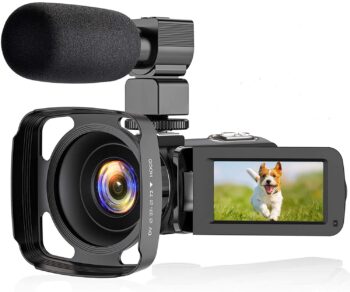
The ZORNIK 2.7K camcorder is an inexpensive model that features an external stereo microphone, a noise reduction filter, a light filter and a wide angle lens. It is an easy to use and powerful camcorder that you can get for less than 100 euros.
76,79 £ on Amazon
The Sony FDR-AX53 records 4K footage with 4 times the detail of Full HD footage. It gives images a dynamic, blur-free life at all times.
642 £ on FnacThe Sony FDR-AX53 offers a good grip. You can hold the camcorder comfortably with your hand and still easily reach the buttons on the top to take a picture, zoom in/out or the Record button on the right side. The compact and handy camera weighs about 655 g. It is activated by pulling the viewfinder or opening the 3-inch LCD touchscreen.
As an evolution of the AX33, the Sony FDR-AX53 inherits the Balanced Optical SteadyShot or BOSS image stabilization technology. The latter makes the lens move inside to compensate for the 4K camcorder's camera shake. BOSS is really great for recording video when you're traveling or taking a close-up video.
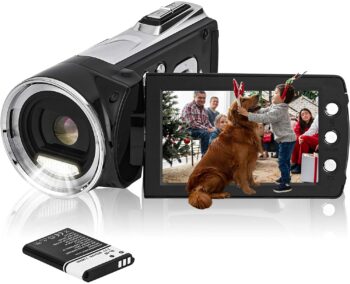
Delivering smooth FullHD video and vibrant photos, the Vmotal HG5162 makes every moment incredible. It is robust and easy to use. These are the main reasons why it is perfect for children and seniors.
See priceAny specific needs?
The best entry-level camcorder
Excellent camcorder for kids and seniors
Your guide :
Rate this buying guide :By rating this buying guide, you are helping us to reward our best writers. Thank you!
| TOP OF THE TOP | CHEAP | TOP OF THE LINE | EXCELLENT | |

In accordance with our commitment, this buying guide does not contain any sponsored products. |
 9/10 |
 7/10 |
 8/10 |
 8/10 |
| OUR SELECTION |
Sony HDR CX240
|
ZORNIK 2.7K
|
Sony FDR-AX53
|
Vmotal HG5162
|
|
The Sony HDR-CX240 is the successor to the HDR-CX220 and still offers excellent value for money. This camcorder can capture Full HD video, has image stabilization, advanced zoom and image preset modes. It is suitable for both professionals and amateurs.
|
The ZORNIK 2.7K camcorder is an inexpensive model that features an external stereo microphone, a noise reduction filter, a light filter and a wide angle lens. It is an easy to use and powerful camcorder that you can get for less than 100 euros.
|
The Sony FDR-AX53 records 4K footage with 4 times the detail of Full HD footage. It gives images a dynamic, blur-free life at all times.
|
Delivering smooth FullHD video and vibrant photos, the Vmotal HG5162 makes every moment incredible. It is robust and easy to use. These are the main reasons why it is perfect for children and seniors.
|
|
|
Maximum video resolution
|
FullHD (1920x1080 pixels)
|
2.7K (2688x1520 pixels)
|
20x optical zoom / 30x-40x Clear Image zoom
|
FullHD (1920x1080 pixels)
|
|
Image sensor
|
Carl Zeiss 9.2 MP
|
CMOS 8 MP
|
4K UHD (3840x2160 pixels)
|
CMOS 12 MP
|
|
Image stabilization
|
Yes
|
No
|
CMOS Exmor R 4K
|
No
|
|
Zoom
|
27x optical zoom / 54x Clear Image zoom
|
16x digital zoom
|
Yes
|
8x digital zoom lens
|
|
Maximum focal length
|
57 mm
|
7.36 mm
|
4.4 - 88 mm
|
7.5 mm
|
Help us improve this table:
Report an error, request the addition of a feature to the table, or suggest another product. Thank you for your kindness!
We spend thousands of hours each year studying the major specialized websites, analyzing products of hundreds of brands and reading user feedback to advise you on the best products.
We are a product review company with a single mission: to simplify your buying decisions. Our research and testing helps millions of people every year find the best products for their personal needs and budget.
To support us you can: use our links to make your purchases (which often earns us a small commission), share our articles on social networks, or recommend our site on your blog. Thanks in advance for your support!
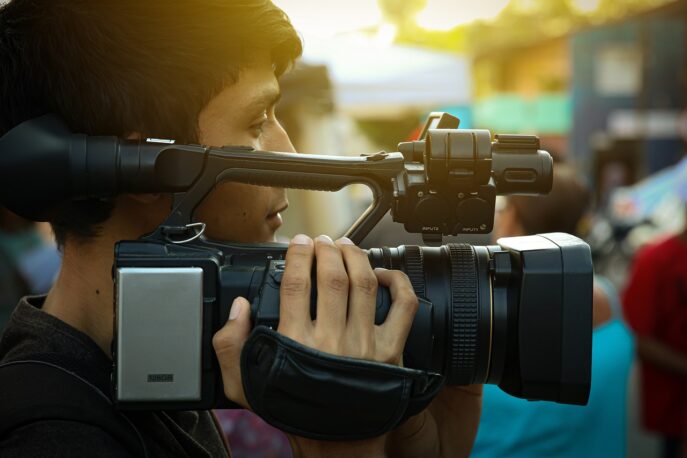
Resolution indicates the number of pixels in the footage, with more pixels providing greater clarity and detail. While a few years ago the choice was between standard definition and high definition, the question now is high definition or 4K. 4K resolution means that the longer side has about 4,000 pixels, which is almost 4 times the resolution of HD. Most HD camcorders have a resolution of 1080p, although a few still use the lower quality 720p. While 4K is a great improvement in quality over HD, the images must be viewed on a 4K screen or monitor to fully experience the superior quality. 4K TVs and monitors are becoming more common, and even YouTube now allows some 4k videos. Watching 4K video on a regular TV only gives you regular HD footage, which is something consumers should consider before spending more on a 4K camcorder.
Digital video is recorded on a sensor inside the camcorder, the size of that sensor plays a big role in video quality. Larger sensors are needed to capture higher resolution, but sensor size can still vary between camcorders with the same resolution. Some 4K camcorders have a large 1-inch sensor while others use a smaller 1 / 2.3 inch. Keep in mind that when comparing two camcorders with the same resolution, the larger one is better. The sensor also plays a role in shooting video with limited lighting. A larger sensor is able to collect more light, so a camcorder with a large sensor will produce better images in low light than one with a small sensor. When the light is low, you'll see a big difference by opting for a larger sensor. So if you plan to shoot a lot of footage in low light, such as at a concert or in a high school gym, a large sensor is ideal.
If you're comparing two cameras with the same sensor and resolution, the other factor to look at is bit rate. Higher bit rates mean larger files, which translates into better video quality when all other factors are the same. Bit rates are usually not as important as resolution or sensor size, but can come into play when comparing two similar cameras. The downside of higher bit rates is that your memory card (or internal memory) will fill up much faster. If you buy a video camera with a high bit rate, you'll also want to get a large, fast SD card, unless the camcorder has a lot of built-in memory.
Most modern camcorders record to an SD card (or mini SD card) or to internal flash memory. The difference between the two is largely convenience. With enough built-in memory, you don't have to buy an SD card or even bring one with you. High-end camcorders with high bit rates and high resolution will have large file sizes and fill an SD card much faster. Large SD cards can be expensive, so camcorders with built-in memory are often more expensive.
Electronic or digital image stabilization relies on software to reduce camera shake. This can be done in a number of ways, but ultimately it is the least effective option. Optical image stabilization stabilizes the video by actually moving parts of the glass inside the lens. This process is much more efficient than electronic stabilization, but often means a higher price tag. Optical image stabilization can also be described by axis, this simply indicates how many different types of motion the camera will compensate for. A camera with 5-axis image stabilization will be stabilized for five different types of motion, where a 3-axis type is only stabilized in three types of motion.
A camcorder needs to be cleaned regularly to stay in good condition. A dirty lens will impact your shot and compromise the quality of your video. If your lens is dirty, you should clean it immediately.
However, you must be extremely careful because the lenses are very fragile. If you don't clean it properly, you may damage it permanently. So, what is the right way to clean a camcorder lens?
Use compressed air
If there's a piece of dust or dirt on your lens, it will show up in every picture you take. Avoid removing it with a brush or wiping it off as there is a high risk of scratching the lens. The best way is to use compressed air to blow out the small debris. You can buy compressed air in a can or you can get a hand blower. Most of the time, a little air is enough to clean the lens.
Use lens cleaners
Sometimes a fingerprint remains on the lens. The best way to clean it is to use lens cleaner. There are also brushes specially designed to remove dirt without scratching the lens.
Video cameras come in many types to suit different shooting styles. The types of video cameras determine several things, such as features and size. Some types are suitable for a variety of different uses, while others are more limited in their intent. Types of video cameras include:
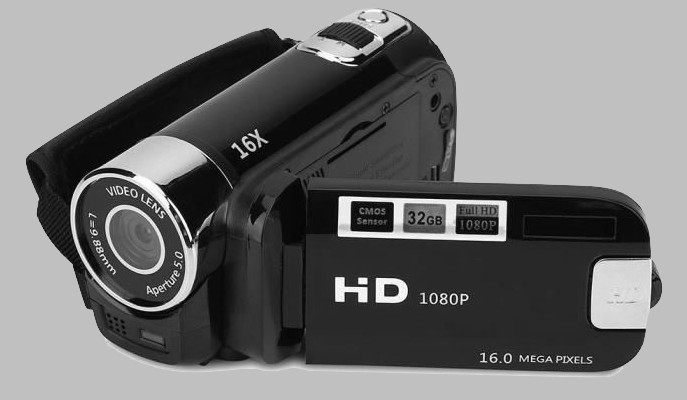
It is a very popular format for documentary filmmakers. However, you should know that the tapes are quickly replaced by hard drives. Depending on your setting (standard playback or long playback), these tapes can give you 60 to 90 minutes of recording time.
Digital videotapes capture footage with little or no compression, so the video quality is excellent. They are essential for archiving and storage as a backup in case your computer or hard drive fails.
The disadvantage is that when scanning tapes to your computer for editing, the footage is captured in real time (one hour of footage takes an hour to import into your computer), whereas when saving to a hard drive, the footage is already in a digital format ready for immediate editing.

This is
the newest type of camcorder. This is also where the jargon gets confusing. HDD (hard drive) is not the same as HD (high definition). HDD camcorders are available in standard definition and high definition.
The hard drive is built into the camera just like your computer. HDD camcorders save money because there is no need to buy tapes or DVDs. You can reuse the hard drive, just as you do with your digital camera.
The disadvantage of a hard drive is that once the drive is full and you need access to a computer or other storage device to download the images and free up space. Also, because a hard drive is made up of moving parts, there is a higher risk of damage from shaking and bumping.
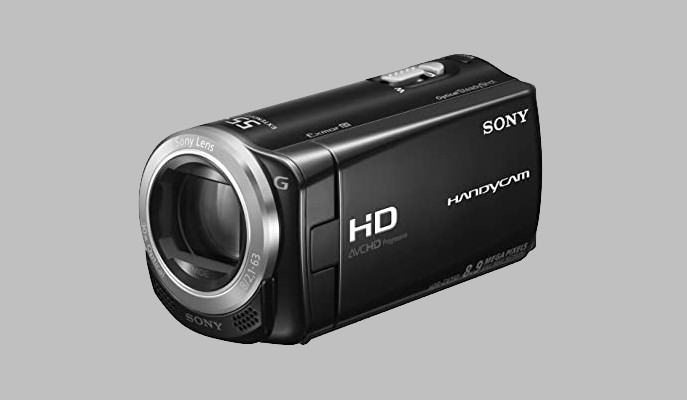
These
types of camcorders store footage on flash memory drives. These are generally smaller cameras.
The two most common formats of flash drives: Memory Stick (Sony products only) and SD / SDHC (used by most other manufacturers). The main advantage is that flash drives have no moving parts like a hard drive, so they are less likely to be damaged.
However, flash memory is more expensive than hard drive memory, about twice as much per gigabyte. So with a hard drive, you get more space for less money, however, it's not as stable. Also, hard drives tend to capture better quality images than flash, but the gap is closing.
The name 4K is used to describe a few different, though very similar, standards. The form you're likely to encounter is Ultra High Definition or UHD, the new standard for 4K television. 4K video is becoming the new standard for recording and viewing video, and it immediately brings many benefits.
Benefits:
Disadvantages:
The 1080p camcorder is considered a quality video resolution for use in TVs and video projectors. Digital displays are made up of pixels, which are arranged in lines or rows. "1080p" refers to a display with 1,920 pixels arranged horizontally and 1,080 pixels arranged vertically. A 1080p camcorder has as many advantages as disadvantages, namely :
Advantages:
Disadvantages:
If you have the ability to shoot with a 4k video camera, and if you have enough internal storage and battery, it is recommended to use a 4K camcorder. Otherwise, opt for a 1080p.

There's no doubt that the camcorder market is evolving. But as smartphones and cameras offer the ability to shoot higher quality HD video, manufacturers are optimizing camcorders.
If you're only taking short clips to share on the Internet, a digital camera or smartphone may be enough. But if you want to shoot the entire soccer game, zoom in on a single player and then watch it on your TV, you need a camcorder. Here are five reasons to choose a camcorder?
Most digital cameras can't record more than 30 minutes of continuous video. The technical specifications detail the maximum recording time for each model. Cameras are not designed for long videos, memory card space and battery life do not allow them.
Just because a camera or phone has 1080p HD video does not mean the quality will be the same as a camcorder with 1080p. Another important factor to consider is frames per second (fps). A good camcorder will record at least 60 fps, while most cameras shoot at 30 fps or less.
Motion such as panning is blurred with slower fps speeds. Camcorders generally have better built-in microphones or ports for adding audio, which means that the audio quality of a camcorder beats cameras and cell phones.
A video can quickly fill a camera's memory card or a smartphone's data. A quality camcorder will come with flash memory that can typically store at least 3 hours of footage, as well as ports to add memory cards for even more storage.
A camcorder has adjustable exposure, a longer zoom range, different focus options and creative filters, to name a few. Most smartphones have little or no zoom and only include the basics. Digital cameras, depending on the model, may not zoom or focus while recording video. When using a camcorder, you have more control over the end results.
Camcorders are designed with a long grip and are generally more comfortable to use. Digital cameras and camcorders can use a tripod for more stable shots, while if a smartphone is tripod compatible, it usually needs a special accessory.
In our opinion, the best brands of camcorders in 2022 are :
Sony's story begins in 1946 with a rice cooker. Over the years, the Japanese brand has become one of the major players in the audio and video industry. Its camcorders are the result of years of development.
Panasonic camcorders were designed for both laymen and professionals and allow excellent high-resolution recordings indoors and outdoors. Its entry-level models are characterized by their ease of use.
In contrast to Canon or Sony, JVC is limited to camcorders and pure audio. The entry-level E and EX series models have been replaced by R models, which are characterized by their waterproof and shockproof housing, but at the same time have all the functions of conventional camcorders.
The GoPro camera was originally designed by current CEO Nick Woodman as a compact way to capture photos and his videos while surfing. Now, GoPro cameras are now used by all kinds of athletes and extreme adventurers, in addition to more casual users.
This brand is known more for its SLR cameras and printers than for its camcorders. But Canon also makes high-quality camcorders. Good equipment for amateurs and professionals alike.
Ensure framing and focus.
Framing is simply the process of positioning your subject. It involves placing the subject properly in the frame of view for maximum effect. If you're using a digital camcorder that displays "safety margin" rectangles toward the outer edge of its viewfinder, it's easier to know that images beyond the outer rectangle may not show up during video playback in some circumstances. Otherwise, try to keep the images in the center of the viewfinder, and not too close to the margins.
Attention to lighting and white balance.
Most digital camcorders, even the most sophisticated and expensive camcorders, tend to have difficulty in low ambient light conditions. In other words, artificial lighting is often necessary, especially when shooting indoors. If you need to use artificial light, beware of shadows and silhouettes, and remember that what appears white in one lighting environment may not be white in others. This is where white balance comes in, usually just focusing the camcorder lens on a piece of white card so that the camcorder perceives white the same way the human eye does.
Use zoom only when needed.
While it is
tempting to demonstrate the zoom capability of your digital camcorder, constantly zooming in and out during your footage can compromise the quality of the video. Try to use zoom sparingly and consider the difference between optical and digital zoom.
Stabilize the camcorder.
The
stability of a digital camcorder during recording is critical to the production of video footage. Although you may think the camcorder is perfectly stable in your hand, the effect of your breathing and muscle fatigue can be amplified by your camcorder. Using a tripod, or a monopod like a tripod, can reduce these effects. Remember, however, to look for a model specifically designed for digital camcorders.
Don't rely on the built-in mic.
Most camcorders have a built-in microphone to capture sound. While this may be more than sufficient for informal gatherings, where sound is not important, it is not for more professional productions. The built-in microphones are not particularly resistant to the effects of external elements. Wind in particular can cause them to sizzle, and the overall quality of the recorded sound is generally poor. It may therefore be worthwhile to invest in a lavaliere microphone. A lavaliere microphone is simply a small microphone that can be hung around the neck, or clipped to the front of the subject's shirt.
Anticipate time gaps.
It
is advisable to record a small portion of the video footage, say 5 seconds or so, before and after the footage you actually want to capture. This way you won't lose the first line of an interview or speech. This can be caused by a delay between the moment the record button is pressed and the camcorder starts recording. Also allow enough "pre-roll" for editing equipment to properly acquire a signal. Also, the more shooting you have to do, the more time you have to insert transitions between scenes during the editing process.
In our opinion, the best mid-range camcorder is the Sony FDR-AX33. But the Panasonic HC-V770 offers better value for money. However, the choice depends on your needs and budget. Read our buying guide to learn more.
When
choosing a camcorder, pay attention to some technical details. Pay particular attention to resolution, sensor size, bit rate, memory and image stabilization.
If
you want a camera that can take incredible photos and impressive videos, a camera is a great choice. If the ability to shoot video is your primary requirement, a compact video camera/camcorder is probably your best choice. After all, they are specifically designed for video recording.
The
cost of a camcorder depends mainly on the brand and its options (Full HD, mini DV, 4k etc). The price can vary from about 15 euros to 3000 euros.
In
our
opinion
, the best camcorder brands are: Sony, Panasonic, Gopro, JVC and Canon.
Every month we help more than 1 000 000 people buy better and smarter.
Copyright © 2022 - Made with ♥ by buyingbetter.co.uk
Your reviews and buying guides 0% advertising, 100% independent!